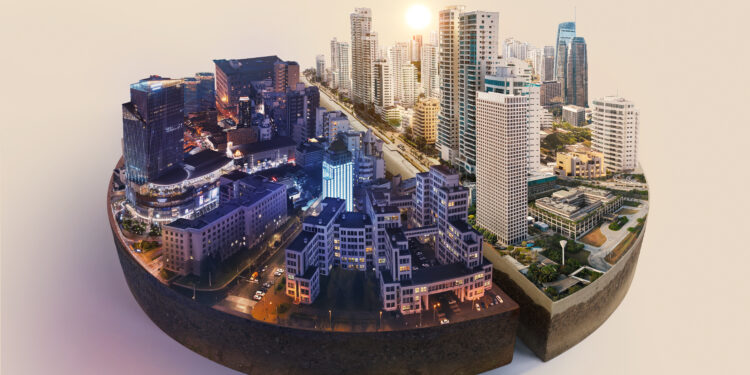India’s cities are growing at an unprecedented pace, with millions migrating to urban areas in search of better opportunities. This rapid urbanization has brought challenges such as traffic congestion, pollution, housing shortages, and infrastructure strain. To address these issues, India has been investing in smart city initiatives, projects that combine technology, planning, and innovation to create more efficient, sustainable, and livable cities. At the heart of these efforts lies digital infrastructure, which is enabling urban areas to deliver better services, improve governance, and enhance quality of life.
The Vision of Smart Cities in India
The concept of smart cities in India is not limited to modern buildings and high-speed internet. It is about integrating technology into the city’s core functions like transportation, water supply, waste management, energy distribution, and security, so they work seamlessly together. Under the Government of India’s Smart Cities Mission, 100 cities have been identified to undergo transformation, each focusing on digital solutions to solve pressing urban problems. The goal is to make cities more citizen-friendly, efficient, and sustainable.
Building the Digital Backbone
Digital infrastructure is the foundation on which smart cities are built. This includes high-speed broadband networks, public Wi-Fi, Internet of Things (IoT) sensors, and data centers. In cities like Pune, Bhopal, and Surat, integrated command and control centers monitor traffic flow, water distribution, and waste collection in real time. These systems collect and analyze data to help authorities make informed decisions and respond quickly to issues, whether it’s a traffic jam, a water leak, or an emergency situation.
Smart Mobility for Efficient Transportation
One of the most visible impacts of smart cities in India is in transportation. Digital infrastructure supports smart traffic management systems that use AI-powered cameras and sensors to monitor road conditions and regulate signals dynamically. Cities like Indore and Bengaluru have adopted intelligent transport solutions, including real-time bus tracking apps and e-ticketing systems. Electric vehicle charging stations are also being set up across major cities, encouraging greener mobility. These advancements not only reduce travel time but also cut fuel consumption and emissions.
Digital Governance for Better Services
Smart cities are transforming governance through technology-driven platforms that allow citizens to access services online. From paying utility bills to lodging complaints, residents can now interact with municipal authorities without standing in long queues. In Bhopal, the “Bhopal Plus” mobile app lets citizens report civic issues, track their status, and even access city information. This digital approach improves transparency, reduces paperwork, and ensures quicker resolution of public grievances.
Enhancing Safety and Security
Digital infrastructure is also making cities safer. Many smart cities have deployed high-definition CCTV networks, automated number plate recognition systems, and AI-based surveillance tools to prevent crime and improve emergency response times. For example, Surat’s Integrated Command and Control Centre has helped reduce crime rates by enabling faster identification and tracking of suspects. Smart street lighting systems that adjust brightness based on pedestrian activity are also improving nighttime safety while conserving energy.
Sustainable Resource Management
Smart cities in India are increasingly focusing on sustainability, and digital tools play a critical role in managing resources efficiently. IoT-enabled water meters help detect leaks and prevent wastage, while smart grids optimize electricity distribution based on demand. Waste management is also becoming more efficient, with GPS-equipped garbage trucks and smart bins that notify collection teams when they are full. Cities like Indore, known for its cleanliness, have leveraged digital solutions to maintain high sanitation standards.
Driving Economic Growth and Innovation
Digital infrastructure not only improves city services but also boosts economic activity. High-speed internet connectivity, smart workspaces, and digital payment ecosystems attract business, startups, and entrepreneurs. Cities like Hyderabad and Pune have seen a rise in tech-driven enterprises thanks to the availability of robust digital systems. Moreover, smart city projects create jobs in sectors like IT, construction, and data analytics, contributing to local economic development.
Challenges in Implementation
While the transformation is promising, building smart cities in India comes with challenges. High implementation costs, integration of legacy systems, and ensuring cybersecurity are significant hurdles. Digital literacy also needs improvement so that all citizens, including those from lower-income groups, can benefit from these advancements. Additionally, urban planning must ensure that technology adoption does not widen the gap between developed and underdeveloped areas within cities.
The Road Ahead
The success of smart cities in India depends on continued investment, policy support, and public participation. Expanding 5G networks, enhancing data security, and fostering private-sector collaboration will be critical for scaling digital infrastructure. Public awareness campaigns can encourage citizens to actively engage with smart city services, ensuring these initiatives meet real community needs. As technology evolves, cities must remain adaptable, embracing innovations like AI-driven urban planning, autonomous public transport, and advanced climate monitoring systems.
Conclusion
Smart cities, powered by robust digital infrastructure, are redefining urban life in India. By integrating technology into everyday services, these cities are addressing long-standing challenges while opening up new opportunities for growth and sustainability. Although there are obstacles to overcome, the progress so far shows that digital transformation can create cleaner, safer, and more efficient cities. As India continues on this path, the vision of truly connected, inclusive, and resilient urban centers is becoming a tangible reality.












